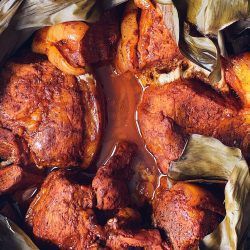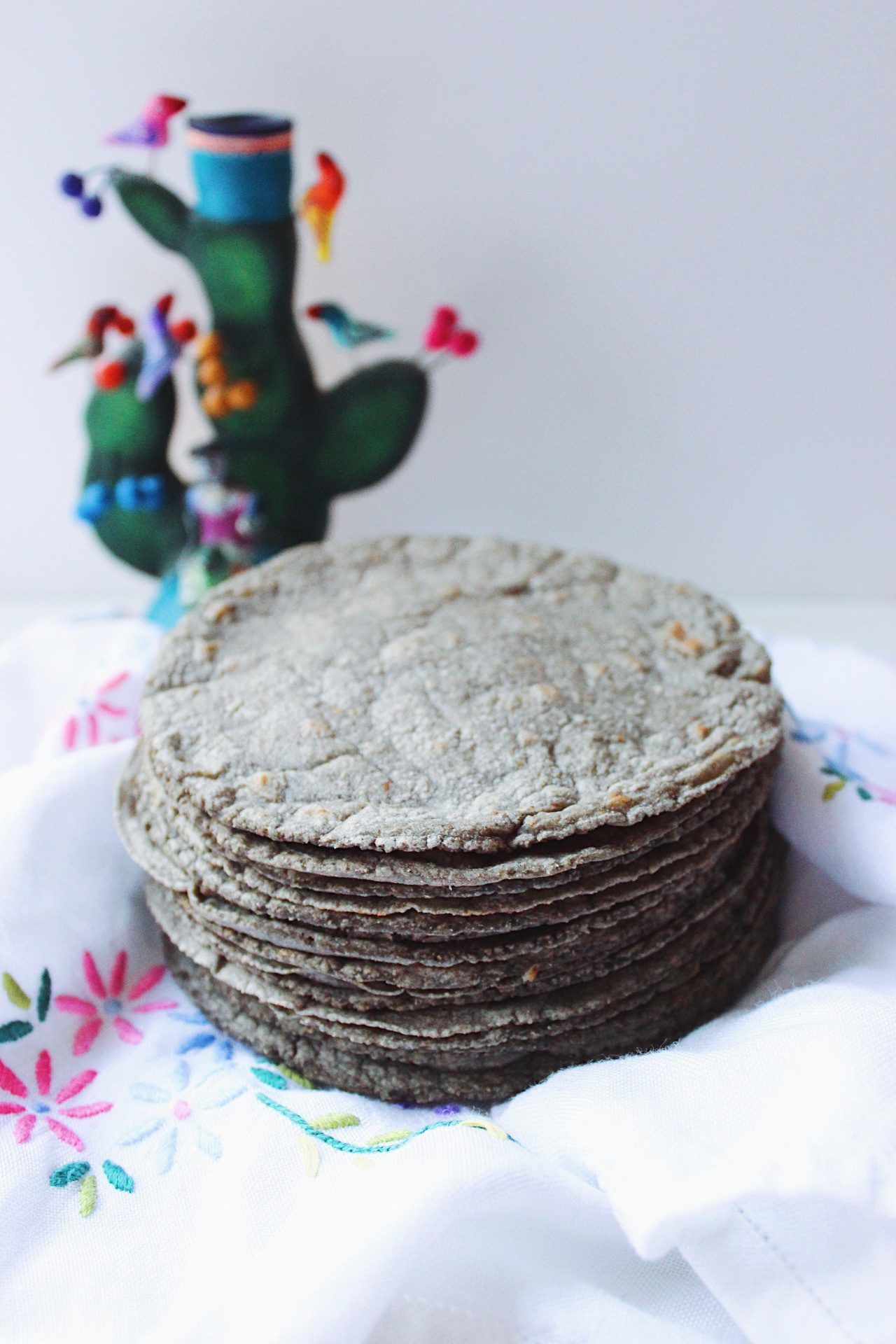
Cochinita pibil is a traditional Mexican dish from the Yucatán Peninsula, made by marinating pork in “recado rojo” or a lot of people also know it as, achiote (a red seasoning made from annatto seeds), citrus juice, vinegar, and spices, then slow-cooking it until the meat is tender enough to shred. The name comes from the Mayan word “pibil,” meaning “underground,” because the dish was originally cooked in a pit oven wrapped in banana leaves. Known for its vibrant color and tangy, earthy flavor, cochinita pibil is typically served with pickled red onions, spicy habanero salsa, and warm tortillas, making it a flavorful, comforting and probably the most popular dish of Yucatecan cuisine.
Okay, real talk: everyone thinks their cochinita pibil is the best—and honestly, that’s fair. It’s one of those dishes with deep roots, big flavor, and endless family versions. I’m not here to say mine is the best, but I can tell you this: it’s really good and always gets rave reviews at our table.
This is our family’s version of cochinita pibil. It’s not cooked in a pit like the traditional Yucatán way, but it’s flavorful, easy enough for a home kitchen, and totally satisfying. Plus, I’ll show you how we eat it at home, with a couple of twists!
When is Cochinita Pibil eaten traditionally?
Cochinita pibil is traditionally eaten on Sundays in the Yucatán Peninsula, when families gather for a big meal after church or to enjoy time together. It’s considered a special weekend dish because it takes time to marinate and cook, so it’s often made when there’s time to prepare it slowly and enjoy it with others.
That said, cochinita pibil is also popular during festivals, family celebrations, and even sold at street food stands throughout the week in Yucatán. In some homes, it’s eaten for breakfast, served as tacos or tortas (sandwiches) with pickled onions and habanero salsa. It’s a dish tied to both tradition and comfort, and while it’s most associated with weekends, it’s welcome on the table any time there’s a craving for something deeply flavorful and satisfying.
Frequently Asked Questions
What is achiote or recado rojo?
Achiote paste (also known as recado rojo) is a spice blend made from annatto seeds, garlic, oregano, and other seasonings. It gives Cochinita Pibil its signature color and earthy flavor.
What cut of pork is best for Cochinita Pibil?
Pork shoulder (also called pork butt or Boston butt in the U.S.) is ideal because it’s marbled with fat and becomes very tender when slow-cooked. Pork leg is also a good option if you want a leaner version.
Can I make it without banana leaves?
Yes! While banana leaves add aroma and moisture, you can skip them and still get great results by slow-cooking the pork in a covered dish or wrapped in foil.
Is Cochinita Pibil spicy?
The pork itself isn’t very spicy—it’s more tangy and earthy. The heat usually comes from the habanero salsa served on the side, so you can adjust the spice level to your liking.
How do you serve Cochinita Pibil?
Traditionally, it’s served with warm corn tortillas, pickled red onions, and spicy salsa. Some people (like in my family) add lettuce and avocado for a fresh twist.
Can I make Cochinita Pibil in advance?
Absolutely. It actually tastes better the next day after the flavors have had time to deepen. Store leftovers in the fridge for up to 3–4 days or freeze for longer storage.
Can I use chicken instead of pork?
Yes! This version is called Pollo Pibil. The same marinade works well with chicken thighs or drumsticks, just adjust the cooking time accordingly. At home, we love using chicken if we don’t want to eat pork.
Ingredient Guide: What Goes Into Cochinita Pibil
Pork (Leg or Shoulder): The main ingredient. Pork shoulder or leg is ideal for slow-cooking because it becomes tender, juicy, and flavorful when braised. Shoulder has more fat (which means more flavor), while leg is a bit leaner but still works well.
Tip: Trim excess fat but leave enough for moisture during cooking.
Achiote Paste (Recado Rojo): This is the soul of Cochinita Pibil. Achiote paste is made from annatto seeds, oregano, garlic, cloves, cumin, and vinegar, giving the dish its bright red color and earthy, tangy flavor.
Find it: In Latin/Mexican markets or the international aisle. Brands like El Yucateco are popular.
Note: It’s not spicy, just bold and aromatic.
Naranja Agria (Bitter Orange): This citrus juice adds tanginess and acidity, which helps tenderize the meat and balance the rich flavors.
Can’t find it? Mix ½ orange + 1 lime (or add a splash of vinegar) as a substitute.
White Vinegar or Lemon Juice: Adds acidity and complements the citrus in the marinade. This keeps the flavor bright and cuts through the richness of the pork.
Optional substitute: Apple cider vinegar or fresh lime juice.
White Onion: Used in the marinade, the onion adds sweetness and moisture and blends beautifully with the garlic and spices during cooking.
Tip: Finely shred it so it melts into the sauce.
Garlic (Minced): Brings depth and savoriness to the marinade. Garlic is essential to round out the bold flavors of achiote and citrus.
Salt and Black Pepper: Simple but necessary. These seasonings help bring out all the flavors in the marinade and meat.
Tip: Taste the marinade before using—achiote paste already contains some salt, so adjust accordingly.
Dried Oregano: Adds a herbal, slightly citrusy note that complements the achiote. Mexican oregano is ideal, but regular oregano works if that’s what you have.
Pickled Red Onions: A classic garnish that brings bright acidity and crunch to each bite. They’re quick to make and essential for balance.
Habanero Salsa: Adds heat and contrast. Cochinita itself isn’t spicy, but a spoonful of fiery habanero salsa on top is traditional in Yucatán.
Tip: Use sparingly—or swap for a milder hot sauce if needed.
Corn Tortillas: The classic vehicle for serving Cochinita Pibil. Soft, warm tortillas make perfect tacos that hold all the flavors together.
Tip: Warm them in a dry skillet or over a flame for best texture.
Avocado & Lettuce: Not traditional, but in my family, we love adding sliced avocado and shredded lettuce for freshness and creaminess. It turns the taco into a full, satisfying bite!

Cochinita Pibil (Pulled Pork Pibil)
Equipment
- 1 cast iron pot
Ingredients
- 1 pound pork leg or shoulder trimmed and cut into small chunks
- 3 tablespoons achiote paste
- Juice of 1 bitter orange or ½ orange + 1 lime
- 2 tablespoons white vinegar or lemon juice
- 1 small white onion grated or finely shredded (or use ½ of a large one)
- 2 garlic cloves minced
- Salt and pepper to taste
- Pinch of dried oregano
- 1 cup water add more as needed
Instructions
Marinate the Pork
- In a blender or food processor, combine: Achiote paste, citrus juice (bitter orange, or orange + lemon), Oregano. Blend until smooth.
- Place the pork in a large bowl and add the minced garlic, shredded onion, salt and pepper, the achiote marinade
- Mix well, cover, and refrigerate for at least 2 hours, or overnight for best flavor.
Cook the Pork
- Preheat your oven to 400°F. Place the marinated pork, adding all the marinade, in an oven-safe dish or Dutch oven. Cover tightly with foil or a lid, and bake for 2 and a half hours, or until tender and easy to shred.
- Taste and adjust seasoning if needed.
Shred the Pork
- Once fully cooked, use two forks to shred the pork. You should be left with juicy, richly-colored meat that practically melts in your mouth. Serve over a corn tortilla and topped with red pickled onion and a tangy, citrus and spicy habanero salsa.


















Evgenia says
Sounds very good…and so colourful
Karla Zazueta says
Thank you 😉 it is very tasty! Have a great day!